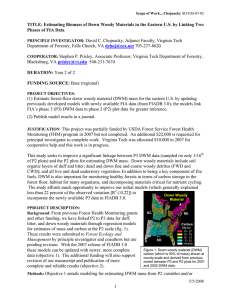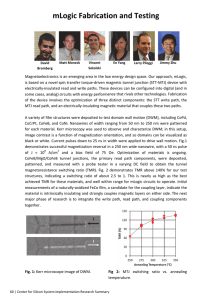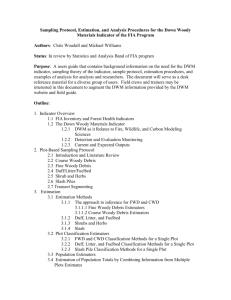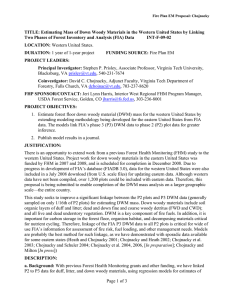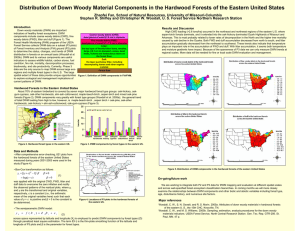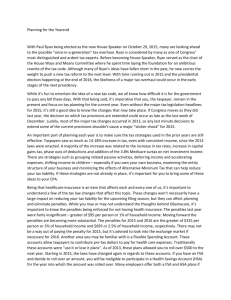Research Note
advertisement
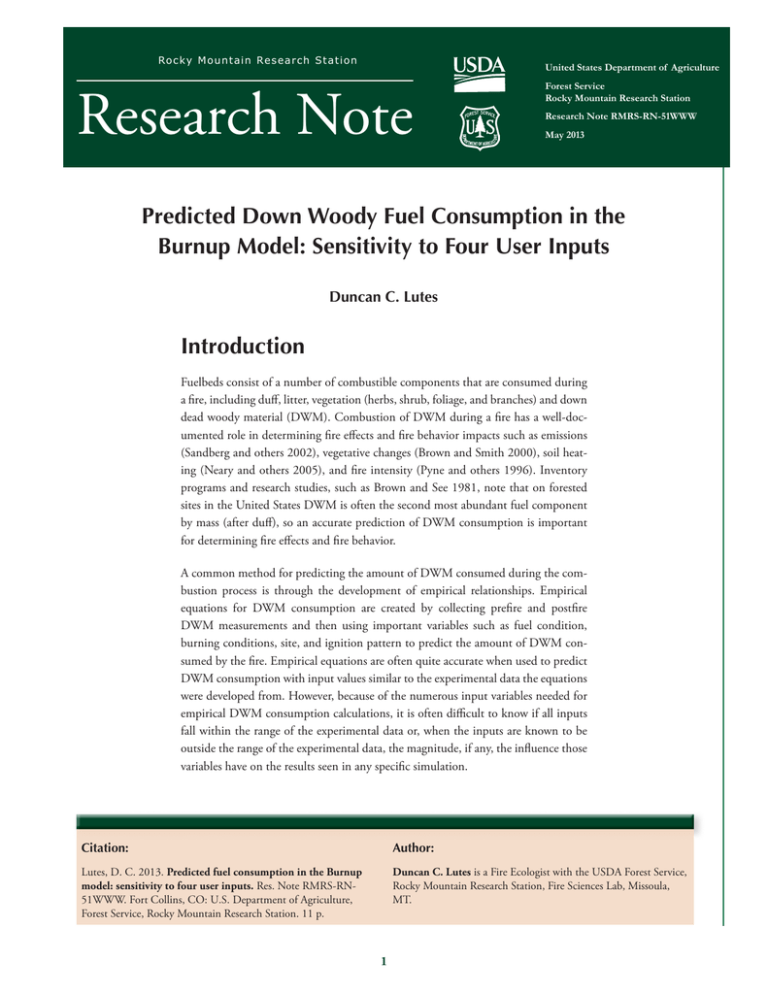
Research Note RMRS-RN-51WWW. 2013 Ro ck y M o u n t a in Re se a r ch S t a t i o n United States Department of Agriculture Research Note Forest Service Rocky Mountain Research Station Research Note RMRS-RN-51WWW May 2013 Predicted Down Woody Fuel Consumption in the Burnup Model: Sensitivity to Four User Inputs Duncan C. Lutes Introduction Fuelbeds consist of a number of combustible components that are consumed during a fire, including duff, litter, vegetation (herbs, shrub, foliage, and branches) and down dead woody material (DWM). Combustion of DWM during a fire has a well-documented role in determining fire effects and fire behavior impacts such as emissions (Sandberg and others 2002), vegetative changes (Brown and Smith 2000), soil heating (Neary and others 2005), and fire intensity (Pyne and others 1996). Inventory programs and research studies, such as Brown and See 1981, note that on forested sites in the United States DWM is often the second most abundant fuel component by mass (after duff), so an accurate prediction of DWM consumption is important for determining fire effects and fire behavior. A common method for predicting the amount of DWM consumed during the combustion process is through the development of empirical relationships. Empirical equations for DWM consumption are created by collecting prefire and postfire DWM measurements and then using important variables such as fuel condition, burning conditions, site, and ignition pattern to predict the amount of DWM consumed by the fire. Empirical equations are often quite accurate when used to predict DWM consumption with input values similar to the experimental data the equations were developed from. However, because of the numerous input variables needed for empirical DWM consumption calculations, it is often difficult to know if all inputs fall within the range of the experimental data or, when the inputs are known to be outside the range of the experimental data, the magnitude, if any, the influence those variables have on the results seen in any specific simulation. Citation: Author: Lutes, D. C. 2013. Predicted fuel consumption in the Burnup model: sensitivity to four user inputs. Res. Note RMRS-RN51WWW. Fort Collins, CO: U.S. Department of Agriculture, Forest Service, Rocky Mountain Research Station. 11 p. Duncan C. Lutes is a Fire Ecologist with the USDA Forest Service, Rocky Mountain Research Station, Fire Sciences Lab, Missoula, MT. 1 Research Note RMRS-RN-51WWW. 2013 Burnup is a research-based mechanistic fuel consumption model that has been developed, tested, and calibrated in previous work (Albini 1994, Albini and Reinhardt 1995, Albini and others 1995, Albini and Reinhardt 1997). Data are brought into Burnup using input files that describe size class (surface area to volume ratio [S/V ratio]), biomass, fuel moisture, wood density, mineral ash fraction, heat of combustion, heat capacity, thermal conductivity, ignition temperature, and char temperature for each fuel component. The basic premise of the model is that adjacency of pieces of woody material primarily determines consumption through local fire intensity. Burnup uses a hierarchical sorting routine to order DWM input data records by increasing diameter (decreasing S/V ratio), increasing moisture content, and increasing wood density. After an initial ignition pulse to ignite fuel components, Burnup logic limits simulated burning interaction so each size class is influenced only by its own and smaller size classes as defined by S/V ratio in the data input file. The ratio of interaction is proportional to the ratio of the diameters of the interacting fuel elements so the closer in size two elements are the more burning interaction there is between the elements (this process is described in detail in Albini 1994 and Albini and others 1995). Fire intensity and fuel consumption are simulated at 15-second time steps from ignition to the end of combustion. The temporal component of Burnup is a significant benefit as the model is able to simulate smoldering and flaming combustion, and intensity, over time. In this study, factorial analysis was used to identify the main effects and interaction(s) of four independent factors—DWM size classification, load, moisture, and rot—on percent DWM consumption simulated in the Burnup model. In standard fuel surveys, dead and down woody material greater than 7.62 cm diameter is typically recorded in 2.54 cm classes but building Burnup input files at that resolution would be tedious and time consuming. On the other hand it would be much simpler to build Burnup input files where fuel load of DWM greater than 7.62 cm was grouped into one class; however, model behavior at that resolution is uncertain. The DWM size classification factor was used in this study to test the accuracy of the model with DWM greater than 7.62 cm grouped into a number of classes based on the piece diameter measured where pieces intersected the sample plane (Brown 1974). Fuel load is typically correlated with piece density—as the fuel load increases, there is greater likelihood of DWM being adjacent or crossing. The interaction of burning DWM is a fundamental component of the Burnup simulation model, so diverse fuel load classes were included in this study to test model sensitivity to variable fuel load and the correlated interaction of burning fuel particles. Fuel moisture affects the amount of oxygen available for combustion and heat flux, and it is important for determining duration of flaming and smoldering (Albini and Reinhardt 1995). The moisture classes used in this study were similar to those used in the First Order Fire Effects Model (FOFEM) (Reinhardt 2003). Consumption of DWM is directly related to the amount of rot present in burned pieces (Albini and Reinhardt1995, Brown and others 1991, Hyde and others 2011). Percent of rot was included to test the sensitivity of Burnup to the presence of rot in DWM. The analysis contained in this research note was undertaken to assist with the incorporation of Burnup in three fire simulation models: FOFEM, FARSITE Fire Area Simulator (Finney and Andrews 1998), and the BehavePlus Fire Modeling System (Heinsch and Andrews 2010). 2 Research Note RMRS-RN-51WWW. 2013 The objectives of the analysis were to: (1) identify the importance of four input variables in estimating the percent total DWM fuel consumption, and (2) identify any interaction between the four tested factors. Methods Data for this study were collected as part of the Gradient Modeling and Remote Sensing (GMRS) study (Keane and others 2002) and consisted of 922 plots sampled on the Kootenai National Forest in northwest Montana and Nez Perce National Forest in central Idaho. The inventory data from the GMRS study were collected along ecological gradients and used as baseline data for mapping important landscape characteristics. The GMRS data were used in this sensitivity analysis because they were collected with consistent field sampling procedures and from diverse ecological types. Specifically, the GMRS dataset provided duff and DWM loading, and duff depth values for the Burnup sensitivity analysis. Of the 922 plots sampled, 141 (15 percent) had no DWM greater than 7.62 cm in diameter and were removed from consideration for this study. The remaining 781 plots made up the study dataset. For simplification of model inputs, duff, litter, and woody fuels less than 7.62 cm diameter were used as found in the study dataset. Herbaceous and live woody fuels were not analyzed. Four Burnup input variables were tested: (1) classification of 7.62 cm and greater DWM, (2) total DWM fuel load, (3) moisture content, and (4) percent of DWM biomass that was considered rotten. The study used a balanced factorial experiment with 20 observations per cell to identify effects on the dependent variable: percent total DWM consumed. “Percent total DWM consumed” in this study was based on the summed total biomass per unit area of pieces 0 to 0.635 cm (1-hr timelag fuels), 0.635 to 2.54 cm (10-hr timelag fuels), 2.54 to 7.62 cm (100-hr timelag fuels), and 7.62 cm and greater DWM components of the fuel complex. The GMRS data were analyzed at three levels of DWM fuel load. Load for each factor level was established as the median total DWM biomass of 20 samples around the 10th, 50th, and 90th percentiles (10 samples either side of the percentile) of the 781 plots in the study dataset. These 60 samples provided the fuel load data used in this study. The class factor described how the load of DWM greater than 7.62 cm in diameter was grouped for input to the model. For each of the 60 GMRS study plots identified above, the fuel load of DWM greater 7.62 cm was calculated using standard equations (Brown 1974) by grouping log diameters into the five classes listed in table 1. Each of the five classes was considered a factor level in this study. The 4-class factor level closely corresponded to the classification used by Albini and others (1995) in validation tests. Fuel size within Burnup is actually defined by S/V ratio, not diameter. Diameter was used to describe fuel classes only because it is more intuitive to most readers than S/V ratio. S/V ratio for each class was calculated with the formula: 4 S/V ratio = dl + 4 du where, 2 dl is the diameter at the lower class limit, in meters and du is the diameter at the upper class limit, in meters. 3 Research Note RMRS-RN-51WWW. 2013 Table 1—Biomass of DWM greater than 7.62cm was distributed into these five levels based on piece diameter at point of intersection with sampling plane. Fuel factor levels Load factor classes (cm) Load factor classes (in.) 19-class >7.62 to 10.16, >10.16 to 12.70, >12.70 to 15.24, >50.80 >3 to 4, >4 to 5, >5 to 6…>20 6-class >7.62 to 15.23, >15.23 to 22.85, >22.85 to 30.47, >3 to 6, >6 to 9, >9 to 12, >12 to 15, >15 to 20, >20 >30.47 to 38.09, >38.09 to 50.79, >50.8 4-class >7.62 to 15.23, >15.23 to 22.85, >22.85 to 50.80, >50.80 >3 to 6, >6 to 9, >9 to 20, >20 3-class >7.62 to 22.85, >22.85 to 50.79, >50.80 >3 to 9, >9 to 20, >20 1-class >7.62 >3 Moisture content was tested at the four factor levels presented in table 2. The levels used for DWM fuel moisture were similar to the default fuel moisture classes used in FOFEM, which were developed with input from researchers and managers in the western United States. The study dataset was analyzed to determine levels of the proportion of rot factor. The condition of DWM greater than 7.62 cm was recorded in the GMRS study as one of five condition classes (Maser 1979). In this study condition classes 1, 2, and 3 were considered sound DWM, and classes 4 and 5 were considered rotten DWM. In the Burnup model, two characteristics differentiate rotten wood from sound wood: (1) rotten wood has lower wood density (224 Kg/m3 for rotten fuel vs. 513 Kg/m3 for sound fuel) and (2) rotten wood has a lower ignition temperature than sound wood (302 degrees C vs. 327 degrees C). These figures come from Albini (1994) and were used in the Albini and others (1995) calibration study. In simulation input files the fuel moisture for rotten DWM greater than 7.62 cm was set at 250 percent that of the sound fuels. This multiplier was found in the original Burnup development files and may be suspect. For example, Brown and others (1991) noted fuel moisture of rotten DWM greater than 7.62 cm was 175 percent and 140 percent greater than sound material in spring and fall, respectively. Two factorial analyses were used to examine data. The first was used to identify the factors that significantly influenced the percent total DWM consumed. Then those results were used to reduce the number of factors and/or levels where appropriate. The second analysis was again used to look for important factors in the reduced model but also to identify significant interactions between levels. Heterogeneous variance and non-normality were present in the analysis. Alternative analyses (arcsin transformation, trimmed mean and Welch-type analysis of variance for multiple factors [Wilcox 1997]; Kruskal-Wallis analysis for single factors) were computed to assess sensitivity of results to violation of homogeneous variance and normality Table 2—Four fuel moisture levels were tested as inputs to Burnup to identify significant differences in the model’s output. Percent moisture Fuel size Very dry Dry Moderate Wet 0 to 0.635 cm 0.635 to 2.54 cm 2.54 to 7.62 cm 7.62+ cm Duff 3 4 6 13 40 6 8 10 15 75 9 11 15 20 120 11 14 18 35 195 4 Research Note RMRS-RN-51WWW. 2013 assumptions of the factorial analyses. No concerns were identified in these secondary analyses. Therefore, only the factorial results for the untransformed data are reported here. Variation within individual factors was interpreted using the Tukey-Kramer HSD multiple comparison procedure. A significance value of 0.05 was used to identify significant factors throughout this study. Results and Discussion The median load of the low, medium, and high total DWM load levels corresponded to 0.49 kg m-2 (2.19 tons ac-1), 3.16 kg m-2 (14.10 tons ac-1), and 9.52 kg m-2 (42.49 tons ac-1), respectively (table 3). Of 781 plots in the study dataset, 7 percent of the plots had 100 percent of the DWM 7.62 cm and greater diameter recorded as sound and 27 percent of the plots had 100 percent of the DWM 7.62 cm and greater diameter recorded as rotten. The 10th, 50th, and 90th percentiles of the proportion of rotten fuels calculated from the study dataset were used as the three levels of rot: low=8 percent rotten total DWM load, moderate=77 percent, and high=100 percent. At each level the same proportion of rot was applied to all 1-hr, 10-hr, 100-hr, and the 7.62 cm and greater DWM. First Analysis Analysis of variance found the model as a whole was significant (p < 0.001). Percent total predicted DWM consumption was significantly influenced by each of the four factors (p < 0.001). Two interesting relationships emerged while examining the within-factor significance tests. First, within the fuel class factor the only significant difference from the grand mean of consumption was for the 1-class level (p < 0.001). Tests using Tukey-Kramer HSD confirmed this significance. Predicted percent consumption of the other class factor levels was not significantly different than the grand mean or each other. The greater consumption simulated with the 1-class level was due to having all the 7.62 cm and greater fuel represented by one S/V ratio in the Burnup input file, thus all simulated interaction was within the same size class rather than across several size classes. Because Burnup was calibrated with the 7.62 cm and greater fuels separated in multiple elements and, in this study, all the fuel class factor levels with multiple elements had similar simulated consumption, the 1-class factor was deemed to be the unusual case and removed. Second, Tukey-Kramer analysis found an insignificant difference between the dry and very dry levels of the moisture class (p = 0.082). The value was marginal relative to the other p-values so both levels were retained. Table 3—Minimum, median, and maximum total DWM biomass for each load level. Load level Minimum Median --------------------------kg Low Medium High 0.43 (1.91) 3.09 (13.79) 9.10 (40.58) m-2 (t 0.49 (2.19) 3.16 (14.10) 9.52 (42.49) 5 Maximum ac-1)--------------------------0.56 (2.49) 3.26 (14.54) 9.91 (44.20) Research Note RMRS-RN-51WWW. 2013 Second Analysis The 4X3X4X3 balanced factorial analysis examined the significance of main effects, the two-, three-, and four-way interactions, and the significance of each level in determining percent total DWM consumption (table 4). Model Test The second factorial experiment resulted in a significant but poorly explained relationship (table 5). The low R-square is not surprising because the analysis only examined four user inputs so other important model inputs were held constant and not tested. The shortcoming of testing the model this way was that unaccounted variation remained in the residual error which desensitized the F-tests, increasing the chance of a Type II error. Factor profiles for class, load, moisture, and rot are shown in figure 1. Class Factor Test With the 1-class factor level removed from the analysis, the class factor was not a significant effect in the model (F = 2.06, p(F) = 0.1034). Tukey-Kramer tests found a relatively high p-value for the 19-class vs. 3-class factor level (p = 0.068). Other factor levels had lower p-values. The following tabulation includes the differences of mean predicted percent total DWM consumption and (p-value) for all Tukey-Kramer comparisons of the class factor: Level 6-Class 4-Class 3-Class 19-Class 1.2 (0.831) 1.4 (0.714) 3.3 (0.068) 6-Class 4-Class 0.3 (0.997) 2.2 (0.379) 1.9 (0.507) Table 4—Factors and levels used in the final factorial analysis were selected after initial analysis determined that the 1-class factor level was not significant. Factor Level Class 3-Class 4-Class 6-Class 19-Class Load Low Medium High Moisture Very Dry Dry Moderate Wet Rot Sound Moderate Rot Table 5—Results of the final factorial analysis noted a significant but poorly explained relationship. n 2880 Root mean square error R-square (adjusted) F p(F) 25.86 0.253 6.48 <0.0001 6 Research Note RMRS-RN-51WWW. 2013 Figure 1—Factor profiles for class, load, moisture, and rot. Bars represent 95% confidence intervals. Load Factor Test The Load factor significantly influenced percent total DWM consumption (F = 29.4, p(F) < 0.001); however, there was no significant difference in percent total DWM consumption estimated at the high and low factor levels (p = 0.092) when tested using Tukey-Kramer HSD. Tests of low vs. medium and medium vs. high levels found significantly different percent total DWM consumption (p < 0.001). The relationship of percent consumption at these levels was not immediately intuitive as percent consumption was higher at the moderate load level than at the low or high levels (fig. 1). An untested explanation for this has to do with the interaction between burning pieces as modeled in Burnup. At the low load level, the sparse spatial distribution of pieces did not allow the energy from one burning piece to greatly effect the burning of adjacent pieces. At the high load level pieces interacted substantially but, because absolute DWM load was high, the percent DWM consumption was lower than for the moderate fuel load level. Also, in the study dataset, median piece diameter at the high fuel load level was 17.8 cm (7 in.) compared to 127 cm (5 in.) at the low and medium load levels and large pieces with low surface area to volume ratio may not have burned as completely as DWM in the low and medium levels. At the moderate level the spatial distribution of pieces and modest fuel load allowed the simulated interaction of elements to effectively increase the percent DWM consumed above the other two levels. The following tabulation includes the differences of mean percent total DWM consumption and (p-value) for all Tukey-Kramer comparisons of the load factor: Level Medium High Low 8.8 (<0.001) -2.5 (0.092) Medium -6.3 (<0.001) Moisture Factor Test Moisture factor significantly influenced percent total DWM consumption (F = 197.3, p(F) < 0.001). Tukey–Kramer comparison of the dry vs. very dry factor found an insignificant difference in consumption (p = 0.137) at those two levels. Other withinfactor significance tests indicated highly significant relationships (p < 0.001). The moisture factor explained more model variation than any of the other factors in the model, with the wet level responsible for much of that variation. 7 Research Note RMRS-RN-51WWW. 2013 The following tabulation includes the differences of mean percent total DWM consumption and (p-value) for all Tukey-Kramer comparisons of the moisture factor: Level Moist Dry Very Dry Wet 20.1 (<0.001) 27.1 (<0.001) 30.0 (<0.001) Moist 6.2 (<0.001) 9.2 (<0.001) Dry 2.9 (0.137) Rot Factor Test Proportion of rotten DWM significantly influenced the percent total DWM consumed (F = 109.2, p(F) < 0.001). Each of the levels significantly affected the percent DWM consumed and fuel consumption between levels behaved in an intuitive way—percent consumption increased as percent rotten fuel load increased (fig. 1). Albini and others (1995) and, more recently, Hyde and others (2012) confirmed this relationship. The following tabulation includes the differences of mean percent total DWM consumption and (p-value) for all Tukey-Kramer comparisons of the rot factor: Level Moderate Rotten Sound 12.5 (<0.001) 16.8 (<0.001) Moderate 4.3 (0.001) Factor Interaction There was little interaction noted in this analysis, perhaps because the moisture factor explained much of the model variation, relative to the other levels (table 6). The only significant interaction was between load and rot, with increasing consumption as load and proportion of rot increased (fig. 2). This interaction is a combination of two model processes previously discussed: (1) other factors being equal, proportionally less total DWM biomass was consumed at the high fuel level because there was proportionally less consumption of the large diameter DWM and (2) percent rotten fuel load increases total DWM consumption. Thus, the interaction is due to proportionally more rotten DWM being consumed at the high loading level because the large DWM did not burn as completely when sound as it did when rotten. Table 6—Of eleven interactions tested, only the load vs. rot interaction was significant. One of the remaining 10 interactions, load vs. moisture, showed a moderate significance. Source Class-Load Class-Moisture Class-Rot Load-Moisture Load-Rot Moisture-Rot Class-Load-Moisture Class-Load-Rot Class-Moisture-Rot Load-Moisture-Rot Class-Load-Moisture-Rot F Ratio Prob>F 0.11 0.003 0.029 1.94 8.87 0.05 0.027 0.061 0.006 0.135 0.003 0.999 1.000 0.999 0.0710 <0.0001 0.999 1.000 1.000 1.000 0.999 1.000 8 Research Note RMRS-RN-51WWW. 2013 Figure 2—Interaction profiles for all factor levels. The only significant interaction was between load and rot. Conclusion There are two specific recommendations that result from the analyses. First, when organizing Burnup input data, avoid distributing log diameters for DWM 7.62 cm (3 in.) and greater into classes more coarsely than the 4-class distribution: >7.62 cm to 15.23 cm, >15.23 cm to 22.85 cm, >22.85 cm to 50.79 cm, and >50.79 cm (3 in. to 6 in., 6 in. to 9 in., 9 in. to 20 in., and diameters greater than 20 in.), or something that closely approximates that classification. This classification appeared to give robust answers with a minimum of DWM classification effort. These results should not be interpreted to suggest that large size DWM only need be tallied by size class in the field. Large DWM is an important component for wildlife, nutrient cycling, and carbon processes (Harmon and others 1986) so the diameter should be recorded to, at least, the nearest 2 cm for accurate estimates of large DWM, then grouped into classes for Burnup simulations. Second, most of the variation in the model was explained by one factor—moisture. Fuel moisture is not often calculated from fuel samples prior to a prescribed fire; instead, it is inferred from fire danger rating or assigned based on the manager’s experience. The results suggest measured fuel moisture may produce better DWM consumption (and associated emissions) predictions. Likewise, field measurement of wood condition (decay) class is sometimes bypassed to reduce sampling time; however, the results of this study indicate that accurate assessments are important for estimating percent consumption. 9 Research Note RMRS-RN-51WWW. 2013 Acknowledgments I would like to thank Rudy King, Forest Service, RMRS statistician, for his assistance with the statistical analysis, interpretation, and review of this paper, and Bob Keane, Roger Ottmar, and Maureen Kennedy for their helpful review comments. References Albini, Frank A. 1994. Program Burnup: A simulation model of the burning of large woody natural fuels. Unpublished final report for Research Grant INT92754-GR. On file at the USDA, Forest Service, RMRS, Missoula Fire Science Laboratory, Missoula, MT. Albini, Frank A.; Reinhardt, Elizabeth D. 1995. Modeling ignition and burning rate of large woody natural fuels. International Journal of Wildland Fire. 5(2): 81-91. Albini, Frank A.; Brown, James K.; Reinhardt, Elizabeth D.; Ottmar, Roger D. 1995. Calibration of a large fuel burnout model. International Journal of Wildland Fire. 5(3): 173-192. Albini, Frank A.; Reinhardt, E.D. 1997. Improved calibration of a large fuel burnout model. International Journal of Wildland Fire. 7(1): 21-28. Brown, James K. 1974. Handbook for inventorying downed woody material. Gen. Tech. Rep. INT-GTR-16. Ogden, UT: U.S. Department of Agriculture, Forest Service, Intermountain Forest and Range Experiment Station. 24 p. Brown, James K.; See, Thomas E. 1981. Downed and dead woody fuel and biomass in the northern Rocky Mountains. Gen. Tech. Rep. INT-GTR-117. Ogden, UT: USDA Forest Service Intermountain Forest and Range Experiment Station. 48 p. Brown, James K.; Reinhardt, Elizabeth D.; Fischer, William C. 1991. Predicting duff and woody fuel consumption in northern Idaho prescribed fires. Forest Science. 37: 1550-1566. Brown, James K.; Smith, Jane K. eds. 2000. Wildland fire in ecosystems: effects of fire on flora. Gen. Tech. Rep. RMRS-GTR-42-vol. 2. Ogden, UT: U.S. Department of Agriculture, Forest Service, Rocky Mountain Research Station. 257 p. Finney, Mark A.; Andrews, Patricia L. 1998. FARSITE: Fire Area Simulator—A model for fire growth simulation. Fire management notes. 59(2): 13-15. Heinsch, Faith Ann; Andrews, Patricia L. 2010. BehavePlus fire modeling system, version 5.0: Design and Features. Gen. Tech. Rep. RMRS-GTR-249. Fort Collins, CO: U.S. Department of Agriculture, Forest Service, Rocky Mountain Research Station. 111 p. Harmon, Mark E.; Franklin, J.F.; Swanson, F.J.; Sollins, P.; Gregory, S.V.; Lattin, J.D.; Anderson, N.H.; Cline, S.P.; Aumen, N.G.; Sedell, J.R.; Lienkaemper, G.W.; Cromack, K.; Cummins, K.W. 1986. Ecology of coarse woody debris in temperate ecosystems. Advances in Ecological Research. 15: 133-302. Hyde, Joshua C.; Smith, Alistair M.S.; Ottmar, Roger D.; Alvarado, Ernesto C.; Morgan, Penelope. 2011. The combustion of sound and rotten coarse woody debris: a review. International Journal of Wildland Fire. 20: 163-174. 10 Research Note RMRS-RN-51WWW. 2013 Hyde, Joshua C.; Smith, Alistair M.S.; Ottmar, Roger D. 2012. Properties affecting the consumption of sound and rotten coarse woody debris in northern Idaho: a preliminary investigation using laboratory fires. International Journal of Wildland Fire. 21: 596-608. Keane, Robert E.; Rollins, Matthew G.; McNicoll, Cecilia H.; Parsons, Russell A. 2002. Integrating ecosystem sampling, gradient modeling, remote sensing, and ecosystem simulation to create spatially explicit landscape inventories. Gen. Tech. Rep. RMRS-GTR-92. Fort Collins, CO: U.S. Department of Agriculture, Forest Service, Rocky Mountain Research Station. 99 p. Maser, Chris; Anderson, Ralph G.; Cromack, Kermit, Jr.; Williams, Jerry T.; Martin, Robert E. 1979. Dead and down woody material. Chap. 6, pp. 79-95. In: Thomas, J.W. (Ed.), Wildlife Habitats in Managed Forests, the Blue Mountains of Oregon and Washington, USDA For. Serv. Agric. Handb. 553, Washington, DC. Neary, Daniel G.; Ryan, Kevin C.; DeBano, Leonard F. eds. 2005. (revised 2008). Wildland fire in ecosystems: effects of fire on soils and water. Gen. Tech. Rep. RMRS-GTR-42-vol. 4. Ogden, UT: U.S. Department of Agriculture, Forest Service, Rocky Mountain Research Station. 250 p. Pyne, Stephen J.; Andrews, Patricia L.; Laven, Richard D. 1996. Introduction to Wildland Fire. Second Edition. New York; Wiley. Reinhardt, Elizabeth. 2003. Using FOFEM 5.0 to estimate tree mortality, fuel consumption, smoke production and soil heating from wildland fire. Presentation at the 2nd International Wildland Fire Ecology and Fire Management Congress, 16-20 November 2003, Orlando, FL. 6 p. Available online at: http://www.firelab.org/ScienceApps_Files/downloads/FOFEM/FOFEM5Using.pdf. [Verified 8/9//2012] Sandberg, David V.; Ottmar, Roger D.; Peterson, Janice L.; Core, John. 2002. Wildland fire in ecosystems: effects of fire on air. Gen. Tech. Rep. RMRS-GTR42-vol. 5. Ogden, UT: U.S. Department of Agriculture, Forest Service, Rocky Mountain Research Station. 79 p. Wilcox, Rand R. 1997. Introduction to robust estimation and hypothesis testing. San Diego: Academic Press. 296 p. 11 The Rocky Mountain Research Station develops scientific information and technology to improve management, protection, and use of the forests and rangelands. Research is designed to meet the needs of the National Forest managers, Federal and State agencies, public and private organizations, academic institutions, industry, and individuals. Studies accelerate solutions to problems involving ecosystems, range, forests, water, recreation, fire, resource inventory, land reclamation, community sustainability, forest engineering technology, multiple use economics, wildlife and fish habitat, and forest insects and diseases. Studies are conducted cooperatively, and applications may be found worldwide. For more information, please visit the RMRS web site at: www.fs.fed.us/rmrs. Station Headquarters Rocky Mountain Research Station 240 W Prospect Road Fort Collins, CO 80526 (970) 498-1100 Research Locations Flagstaff, Arizona Fort Collins, Colorado Boise, Idaho Moscow, Idaho Bozeman, Montana Missoula, Montana Reno, Nevada Albuquerque, New Mexico Rapid City, South Dakota Logan, Utah Ogden, Utah Provo, Utah The U.S. Department of Agriculture (USDA) prohibits discrimination against its customers, employees, and applicants for employment on the bases of race, color, national origin, age, disability, sex, gender identity, religion, reprisal, and where applicable, political beliefs, marital status, familial or parental status, sexual orientation, or all or part of an individual’s income is derived from any public assistance program, or protected genetic information in employment or in any program or activity conducted or funded by the Department. (Not all prohibited bases will apply to all programs and/or employment activities.) For more information, please visit the USDA web site at: www.usda.gov and click on the Non-Discrimination Statement link at the bottom of the page. Federal Recycling Program Printed on Recycled Paper To learn more about RMRS publications or search our online titles: www.fs.fed.us/rm/publications www.treesearch.fs.fed.us
